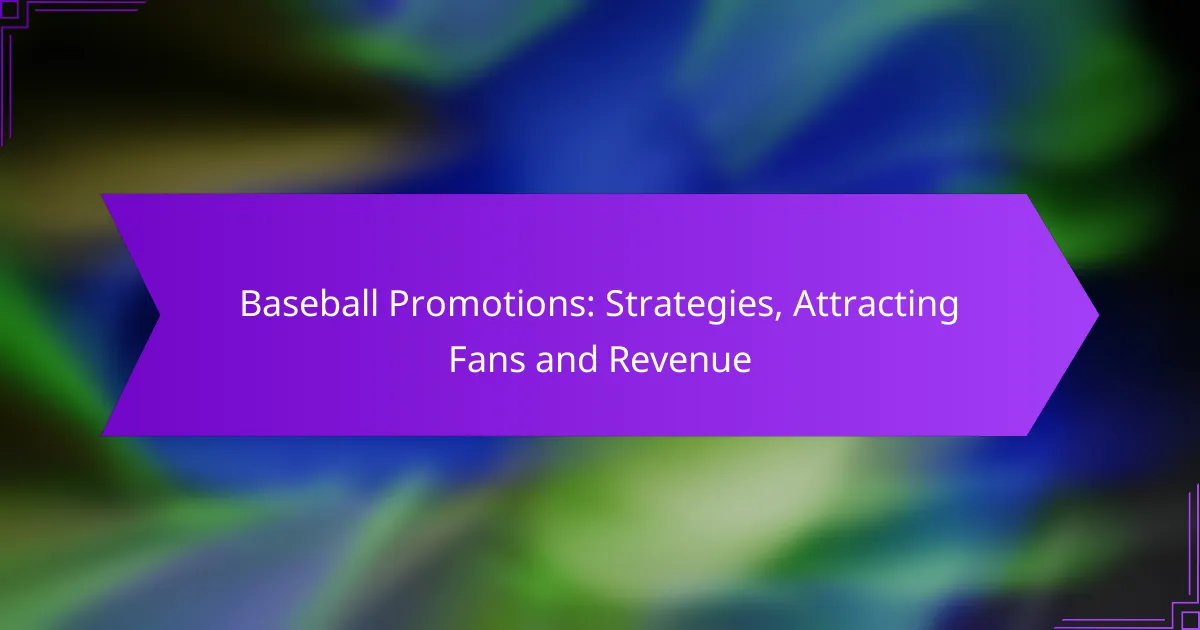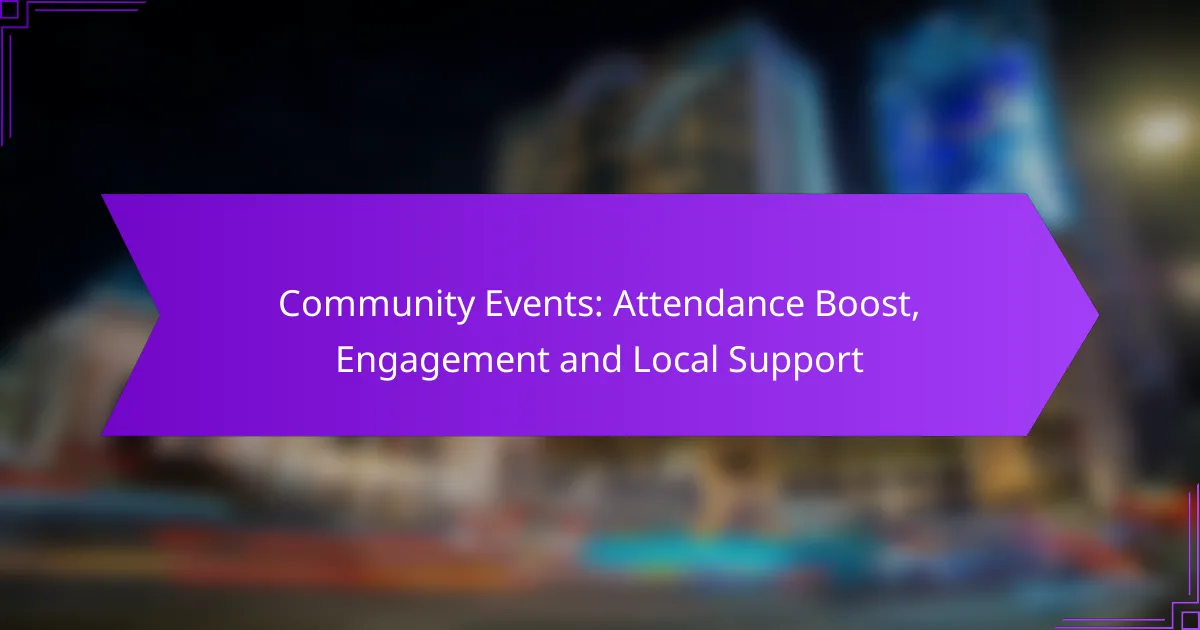Baseball promotions play a crucial role in attracting fans and enhancing the overall game-day experience. By implementing targeted marketing strategies and engaging with the community, teams can significantly boost attendance and revenue. Creative promotions that leverage local partnerships and offer unique experiences are essential for maximizing profitability and fan engagement.
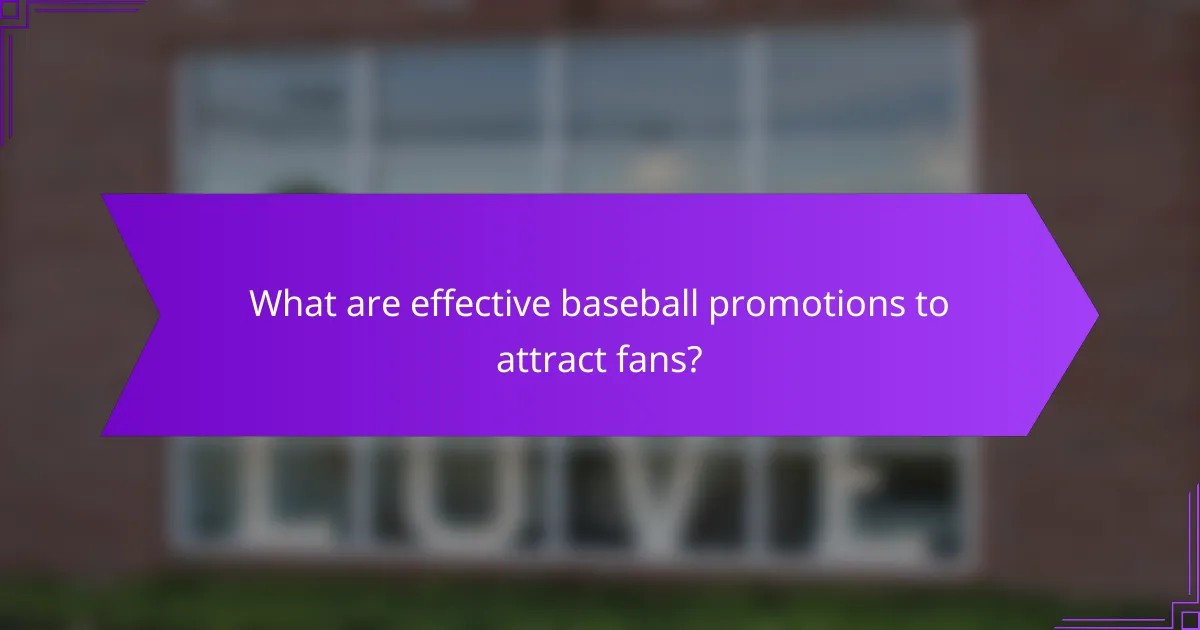
What are effective baseball promotions to attract fans?
Effective baseball promotions to attract fans include a variety of strategies that enhance the game-day experience and create excitement. These promotions can significantly boost attendance, engage the community, and increase revenue through creative marketing efforts.
Themed nights
Themed nights are events where games are centered around a specific theme, such as ’80s Night or Superhero Night. These promotions often include special jerseys, music, and activities that resonate with fans’ interests, encouraging them to attend in costume or participate in themed activities.
Consider offering discounts on themed merchandise or hosting contests related to the theme. This not only enhances the fan experience but also creates additional revenue opportunities through merchandise sales.
Giveaways and contests
Giveaways and contests are popular promotions that can attract large crowds. Items such as bobbleheads, t-shirts, or hats are often given away to the first few thousand fans, creating a sense of urgency to arrive early.
Contests, such as raffles or skill challenges, can engage fans during the game, providing entertainment and the chance to win prizes. Ensure that the prizes are appealing and relevant to your fan base to maximize participation.
Community engagement events
Community engagement events foster a connection between the team and local fans. Hosting events such as youth baseball clinics, charity fundraisers, or school nights can draw in families and promote goodwill.
Consider partnering with local businesses or organizations to enhance these events. This collaboration can help spread the word and create a more significant impact within the community, ultimately driving attendance to games.
Special ticket pricing
Special ticket pricing can make games more accessible to a broader audience. Offering discounts for families, students, or military personnel can attract different demographics and increase overall attendance.
Consider implementing promotional nights with reduced ticket prices or bundled offers that include food and drinks. This strategy can encourage fans to choose your games over other entertainment options.
Celebrity appearances
Celebrity appearances can create buzz and excitement around a game, drawing in fans who might not typically attend. Inviting local sports figures, musicians, or influencers to participate in pre-game activities or throw the first pitch can enhance the game-day experience.
Promote these appearances through social media and local advertising to maximize reach. Ensure that the celebrity’s involvement aligns with your team’s brand and resonates with your target audience for the best results.
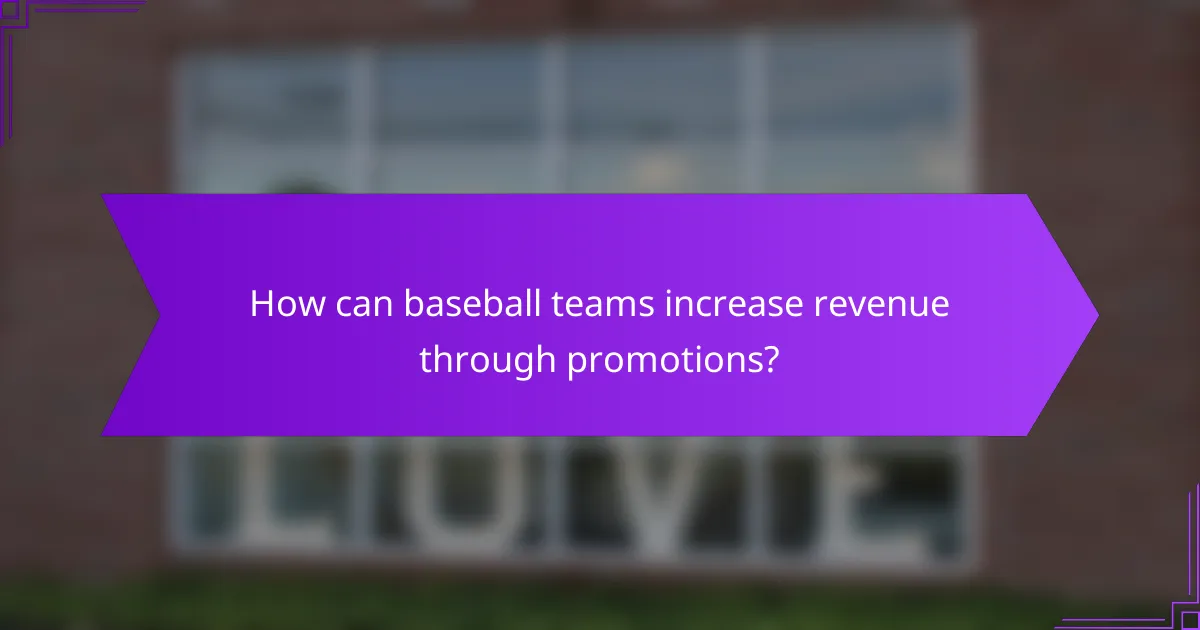
How can baseball teams increase revenue through promotions?
Baseball teams can boost revenue through targeted promotions that engage fans and enhance their game-day experience. By implementing strategies that leverage local partnerships, merchandise sales, premium seating, and food and beverage options, teams can attract more attendees and increase overall profitability.
Partnerships with local businesses
Collaborating with local businesses can create mutually beneficial promotions that draw fans to the stadium. For instance, teams can partner with nearby restaurants or shops to offer discounts or package deals, encouraging fans to spend more both at the game and in the community.
Additionally, local businesses can sponsor events or giveaways, which not only enhances the game-day atmosphere but also fosters a sense of community. Teams should consider creating a directory of local partners to promote during games, increasing visibility for both the team and the businesses involved.
Merchandise sales strategies
Effective merchandise sales strategies can significantly enhance revenue. Teams should focus on offering exclusive items, such as limited-edition jerseys or player memorabilia, that fans can only purchase at the stadium. This creates a sense of urgency and increases the likelihood of impulse buys.
Utilizing online platforms for pre-ordering merchandise can also streamline sales and reduce inventory costs. Teams should promote these items through social media and during games to maximize visibility and sales opportunities.
Premium seating options
Offering premium seating options can attract fans willing to pay more for an enhanced experience. This could include luxury boxes, club seats, or VIP areas with exclusive amenities such as gourmet food and private restrooms. Pricing these options competitively while ensuring a high-quality experience is crucial.
Teams should also consider bundling premium seating with additional perks, such as meet-and-greets with players or complimentary merchandise, to further entice fans. Clear communication about the benefits of these options can help justify the higher price point.
Food and beverage enhancements
Improving food and beverage offerings can significantly enhance the fan experience and increase revenue. Teams should focus on providing a diverse range of options, including local cuisine and healthier choices, to cater to different tastes and dietary needs.
Implementing unique food promotions, such as themed nights or tasting events, can also attract more fans. Additionally, offering bundled food and drink packages can encourage fans to spend more during their visit, enhancing overall revenue.
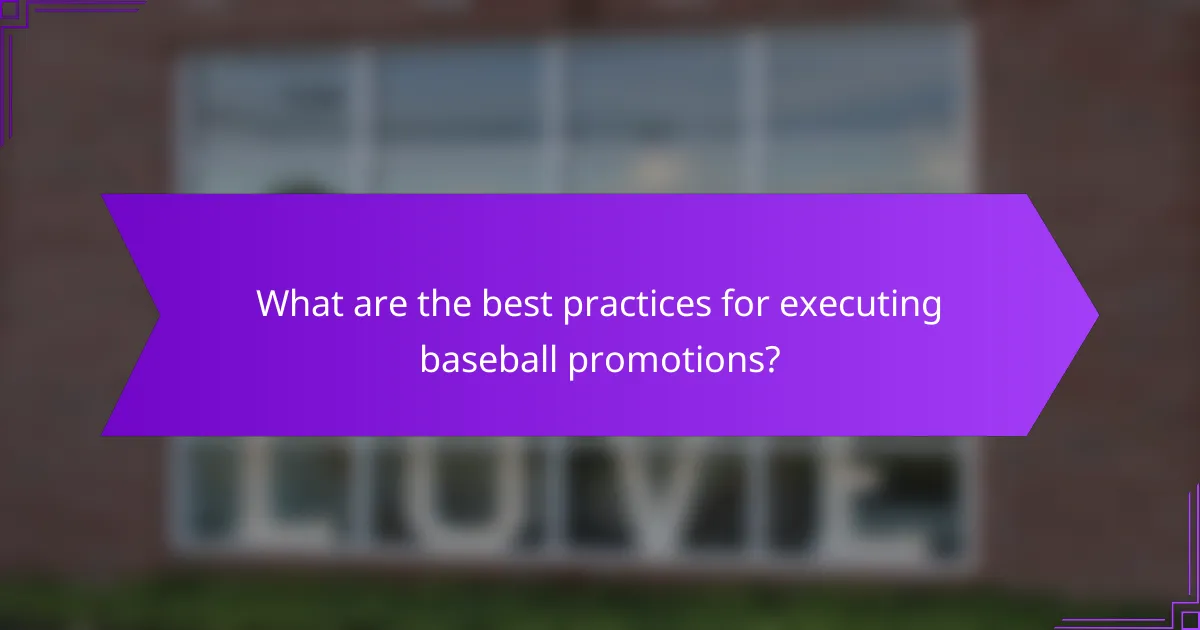
What are the best practices for executing baseball promotions?
Effective baseball promotions rely on strategic planning and execution to attract fans and generate revenue. Best practices include targeted marketing, engaging with fans through social media, and collecting feedback to refine future promotions.
Targeted marketing campaigns
Targeted marketing campaigns focus on specific demographics to maximize outreach and engagement. By analyzing data such as age, location, and interests, teams can tailor promotions that resonate with their audience, increasing attendance and participation.
For instance, offering family packages for weekend games can attract parents with children, while late-night promotions might appeal to younger adults. Utilizing email marketing and local advertising channels can effectively reach these segments.
Social media engagement
Social media engagement is crucial for building excitement around promotions and connecting with fans. Platforms like Twitter, Facebook, and Instagram allow teams to share real-time updates, behind-the-scenes content, and exclusive offers, fostering a sense of community.
Creating interactive content, such as polls or contests, can further enhance engagement. For example, a “name the promotion” contest can encourage fans to participate and feel invested in the event, leading to higher turnout.
Feedback collection from fans
Collecting feedback from fans is essential for improving future promotions and ensuring they meet audience expectations. Surveys can be distributed via email or social media, asking fans about their experiences and preferences regarding promotions.
Incorporating fan suggestions can lead to more successful events. For example, if many fans express interest in themed nights, teams can implement these ideas in future schedules to boost attendance and satisfaction.

What metrics should be used to measure promotion success?
To measure the success of baseball promotions, focus on key metrics such as attendance figures, revenue generated, and fan engagement levels. These metrics provide a clear picture of how well a promotion resonates with the audience and its overall impact on the team’s financial health.
Attendance figures
Attendance figures are a primary indicator of promotion success, reflecting how many fans attended the game as a result of the promotional efforts. Tracking the number of attendees before, during, and after promotions can help identify trends and gauge interest.
Consider comparing attendance figures from promotional games to regular games to assess the effectiveness of specific promotions. For example, a themed night or giveaway can lead to a significant increase in attendance, often in the range of 20-50% more fans.
Revenue generated
Revenue generated from promotions includes ticket sales, merchandise, and concessions. This metric is crucial for understanding the financial impact of a promotion on the team’s bottom line. Analyzing revenue streams can help identify which promotions yield the highest returns.
For instance, a successful promotion might increase ticket sales by several thousand dollars, while also boosting merchandise sales by 10-15%. Tracking these figures over time can help refine future promotional strategies.
Fan engagement levels
Fan engagement levels measure how actively fans interact with the team during promotions. This can include social media interactions, participation in contests, and feedback from surveys. High engagement often correlates with successful promotions and can enhance fan loyalty.
To gauge engagement, consider using metrics such as social media shares, likes, and comments, or conducting post-event surveys. Engaging fans through interactive promotions can lead to increased loyalty and a stronger community around the team.
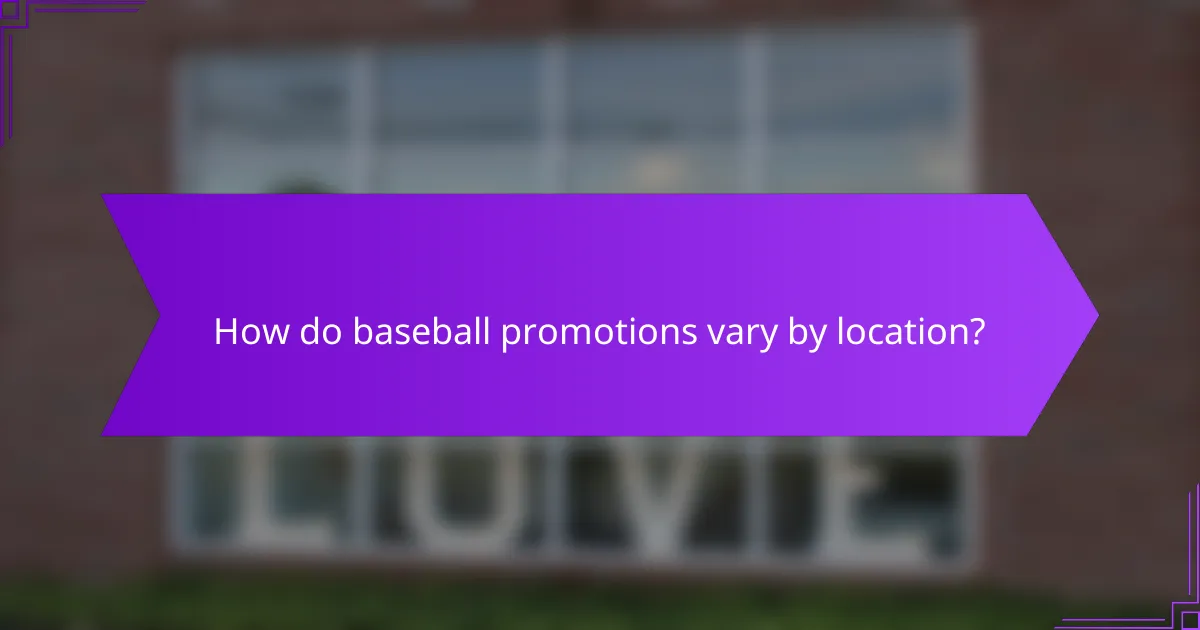
How do baseball promotions vary by location?
Baseball promotions differ significantly by location due to regional preferences, local partnerships, and market demographics. Understanding these factors helps teams tailor their promotional strategies to effectively attract fans and maximize revenue.
Regional preferences
Regional preferences play a crucial role in shaping baseball promotions. For instance, teams in the Northeast may focus on family-friendly events during summer, while Southern teams might emphasize food and music festivals. Recognizing local interests can enhance engagement and attendance.
Additionally, seasonal factors influence promotions. In colder regions, indoor events or winter-themed promotions may be more appealing, while warmer areas can leverage outdoor activities and tailgating experiences. Tailoring promotions to fit these preferences is essential for success.
Local partnerships
Establishing local partnerships can significantly enhance promotional efforts. Collaborating with nearby businesses, schools, or community organizations can create mutually beneficial promotions that attract diverse audiences. For example, a team might partner with local breweries for themed nights or offer discounts to students from nearby colleges.
These partnerships not only boost attendance but also foster community support. Engaging with local sponsors can provide additional funding and resources, making promotions more impactful and cost-effective.
Market demographics
Understanding market demographics is vital for effective baseball promotions. Teams should analyze the age, income, and cultural backgrounds of their fan base to tailor promotions accordingly. For instance, promotions targeting younger audiences might include social media contests or interactive experiences.
Moreover, income levels can influence pricing strategies. Teams in affluent areas may offer premium experiences, while those in lower-income regions might focus on affordable family packages. Adjusting promotions based on demographic insights ensures broader appeal and higher attendance rates.

What emerging trends are shaping baseball promotions?
Emerging trends in baseball promotions focus on enhancing fan engagement, leveraging technology, and creating unique experiences. Teams are increasingly adopting data-driven strategies to attract diverse audiences and boost revenue through innovative marketing efforts.
Fan Engagement through Technology
Technology plays a crucial role in modern baseball promotions, with teams using apps and social media to connect with fans. Interactive experiences, such as augmented reality and mobile ticketing, enhance the game-day atmosphere and encourage attendance.
For instance, some teams offer mobile apps that provide real-time stats, player information, and exclusive content, making fans feel more involved. Utilizing social media platforms for contests and giveaways can also increase engagement and attract new followers.
Unique Themed Events
Themed events are becoming popular as a way to draw in fans and create memorable experiences. These can range from special nights celebrating local culture to unique promotions like “Bark in the Park,” where fans can bring their dogs to the game.
Teams should consider hosting events that resonate with their community, such as charity nights or heritage celebrations. Offering themed merchandise and food can further enhance the experience and encourage fans to attend.
Dynamic Pricing Strategies
Dynamic pricing is an emerging trend that adjusts ticket prices based on demand, maximizing revenue while providing fans with affordable options. This strategy allows teams to respond to market conditions and optimize attendance for each game.
For example, prices may be lower for weekday games compared to weekends or increase as the game date approaches. Teams should monitor attendance patterns and adjust pricing accordingly to ensure they attract a broad audience while maximizing profits.
Partnerships and Sponsorships
Building partnerships with local businesses and sponsors can enhance baseball promotions and provide additional revenue streams. Collaborations can lead to co-branded events, giveaways, and cross-promotional opportunities that benefit both parties.
For instance, a local brewery might sponsor a “Beer Night,” offering discounts on craft beers during the game. These partnerships not only enhance the fan experience but also strengthen community ties and support local economies.
